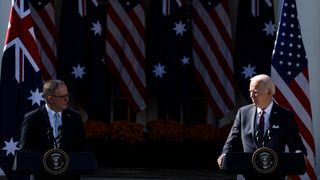In the same week Prime Minister Albanese arrived in Washington DC for a rare state visit to the White House, President Biden’s National Security Advisor, Jake Sullivan, published an essay in Foreign Affairs that is, for all intents and purposes, the ‘Biden Doctrine’ in writing. It is helpful to see the Albanese visit in the context of this emerging doctrine. Every ceremony, every policy announcement, and every photo op has been carefully crafted to advance this agenda. Australians should be clear-eyed in our understanding of where we fit into this agenda, and increasingly, how climate is at the heart of it.
In the essay, Sullivan describes American foreign policy as facing the singular challenge of “competition in an age of interdependence.” More concretely, he argues that the country’s future will be “determined by two things: whether it can sustain its core advantages in geopolitical competition and whether it can rally the world to address transnational challenges from climate change and global health to food security and inclusive economic growth.”
It is helpful to focus on the first of these transnational challenges: climate change. In their joint leaders’ statement, Biden and Albanese announced or reiterated several important new climate initiatives, all of which can be seen to help legitimise and propel the ‘Biden Doctrine.’ That is, they are either useful in US competition with China, or further ballast in the interdependence between the United States and its allies.
Core advantages/Strategic competition
Across the Biden administration’s many essays, speeches, policies, and initiatives, a common theme has been the “hollowing out” of its industrial base and the extent to which that has weakened the United States’ ability to compete with China. In the climate space, Biden has passed a wildly ambitious “green industrial strategy” that could invest as much as US$1.2 trillion in clean energy industries, suddenly placing it among the world’s most ambitious countries on the issue (see chart), and competing with China in critical technologies like electric vehicles, lithium-ion batteries, solar manufacturing, and green hydrogen production.
Most significantly for Australia, this approach includes a large tax credit for electric vehicles, eligibility for which depends on whether 80 per cent of the value of the critical minerals used to produce the batteries is extracted in the United States or a Free Trade Agreement (FTA) country. This puts Australia in the enviable position of having one of the world’s largest endowments of these minerals, deep mining expertise and capacity, and an FTA with what will soon be the world’s second-largest market for these commodities.
To this end, over the last year Australia and the United States have launched several important initiatives designed to accelerate Australian critical minerals supply. This includes the Australia-United States Climate, Critical Minerals, and Clean Energy Transformation Compact (the Compact), which leaders have described as the “third pillar” of the alliance. Within the Compact, there is now a ministerial-level United States-Australia Clean Energy Dialogue, and a US-Australia Critical Minerals Taskforce. The CSIRO and the US Geological Survey have also announced a Memorandum of Understanding to deepen relationships between research on critical minerals, particularly processing.
Most significantly, President Biden is requesting Congress add Australia as a “domestic source” under the US Defense Production Act (DPA). With this in place, Australia would join Canada as a potential destination for US Department of Defense funding to support “domestic production capabilities of such strategic and critical materials by supporting feasibility studies for mature mining, beneficiation, and value-added processing projects.” These feasibility studies would “ready the ground” for capital investments financed through private markets and complement the A$6 billion the Albanese government has committed to its expanded Critical Minerals Facility. While there were some suggestions the DPA legislation would reach the president’s desk in time for the state visit, the extended process of replacing Kevin McCarthy as Speaker of the House scuttled those plans.
Rally the world/Integration
In addition to strengthening the home front, the Biden administration is looking to “modernize” its alliances into “fit-for-purpose partnerships.” This latter phrase is particularly instructive in that it implies, and with good reason, that many of the international institutions and forums that had constructed the network of interdependence between the US and its allies have failed to achieve core transnational objectives; from climate change to poverty eradication.
The climate priorities described by the two leaders reflect this ‘fit-for-purpose’ approach. For example, the upcoming COP28 summit – the world’s largest climate conference and long the centerpiece of global climate diplomacy – is not mentioned once in the statement. This speaks to the administration’s broader shift towards ‘minilateral’ groupings of smaller-scale collaboration based on concrete shared interests. From AUKUS to IPEF to the Quad, Australia is deeply enmeshed in this minilateralist push.
Ultimately the question is whether this shift advances the decarbonisation agenda by focusing state efforts or fragments them into an ineffective mess. However, COP has been something of an ineffective mess for quite some time, and indeed has implicitly promoted a less centralised approach ever since the 2015 Paris Agreement shifted towards the individual state ‘pledge and review’ mechanism. With each passing year, the global consensus-building of the COP process becomes less important to climate mitigation, while the plethora of regional, sectoral, and technological agreements on its fringes take on increasing prominence.
This problem-solving logic of climate minilateralism was on display in the limited announcements made during the PM’s visit. The two leaders emphasised regional initiatives in the Indo-Pacific, such as the Australian Infrastructure Financing Facility for the Pacific, efforts to support methane mitigation in the region, and the potential to coordinate on clean energy in the Indo-Pacific Economic Framework. Here you see the two countries focusing on tangible challenges in the region’s transition to clean energy and, significantly, no mention of unrealistic fossil fuel phaseout schemes or carbon pricing frameworks.
Of course, it is unclear if the United States can pull all this off, or what role Australia is willing to play in helping them do so. What is clear is that the existing approach was not working. The alphabet soup of new trade agreements, regional initiatives, and minilateral groupings might appear chaotic and disjointed, but they are undoubtedly experiments in a new decarbonisation diplomacy that emphasises problem-solving over pledges, and projects over platitudes. Australia, perhaps whether we know it or not, is playing an important role in legitimising this project of strategic competition amidst fit-for-purpose integration, giving us a powerful opportunity to shape it in the process.






